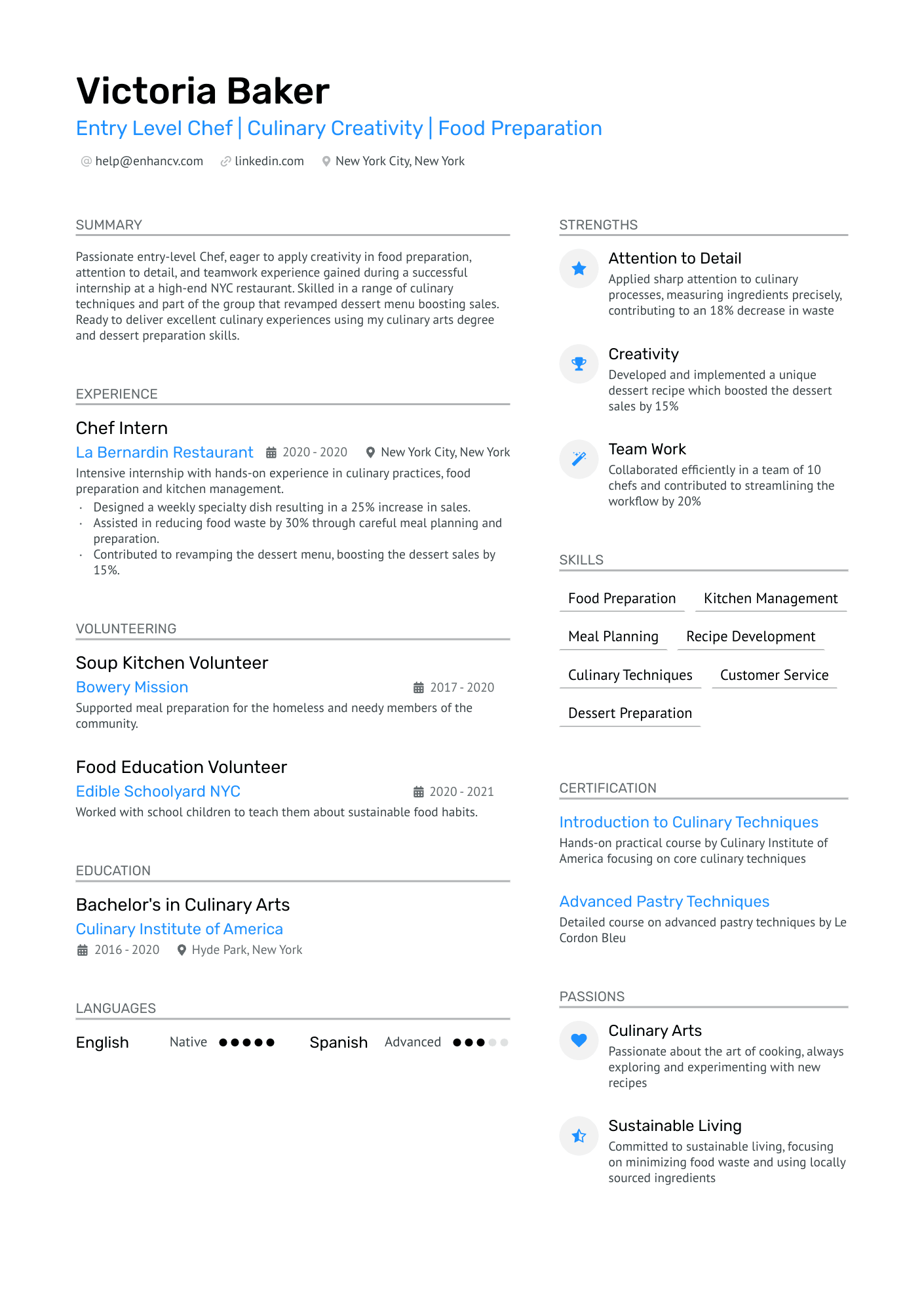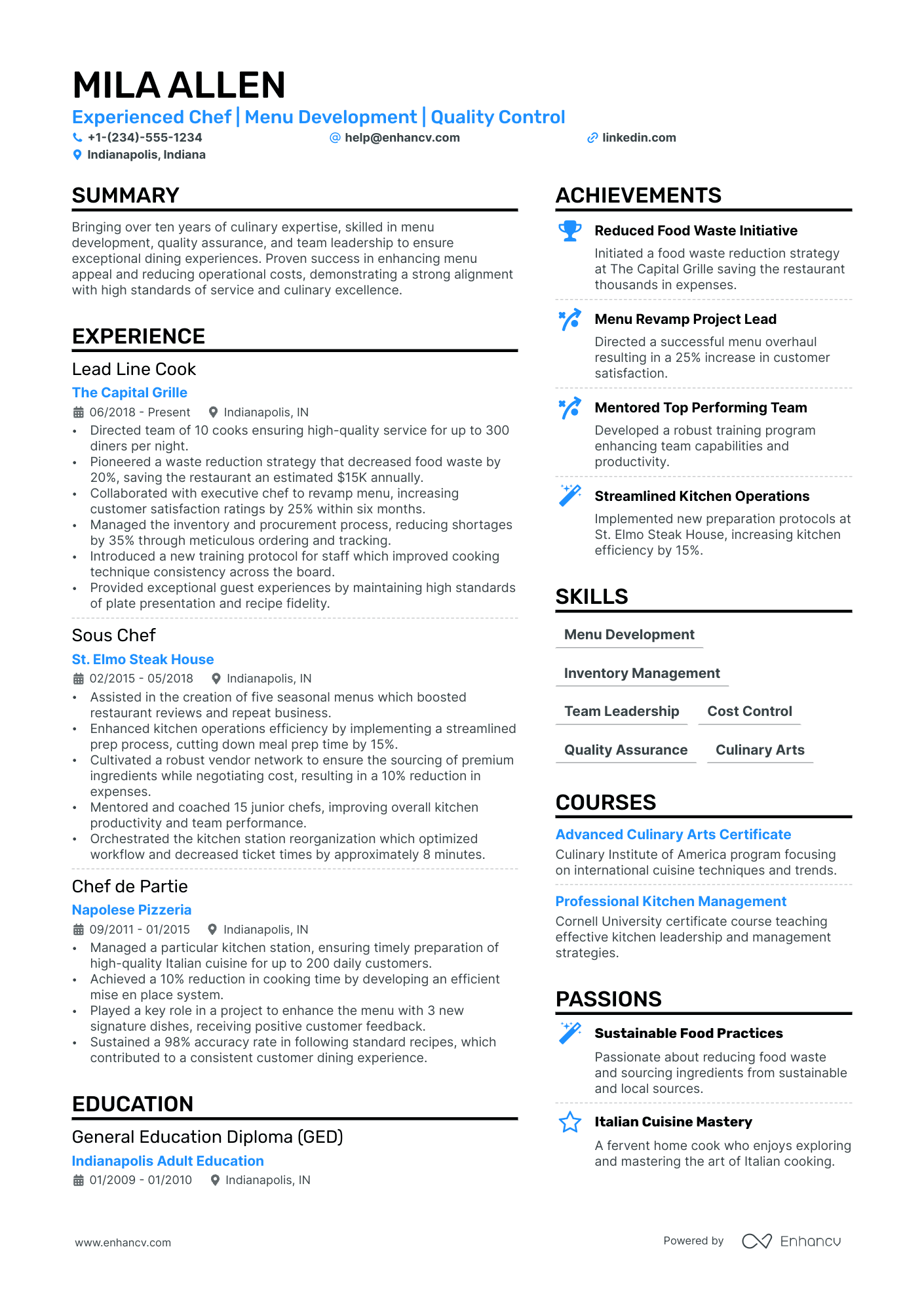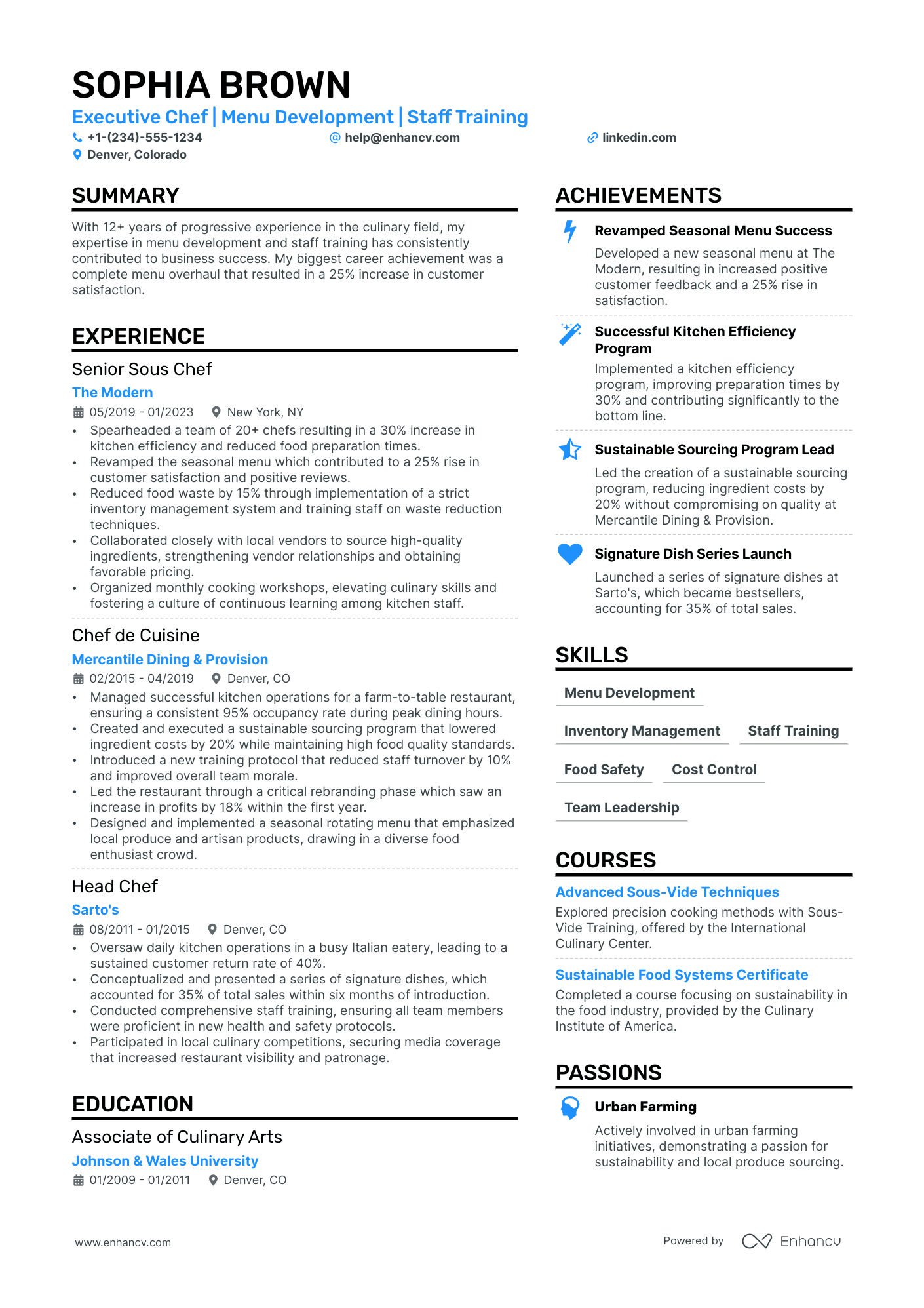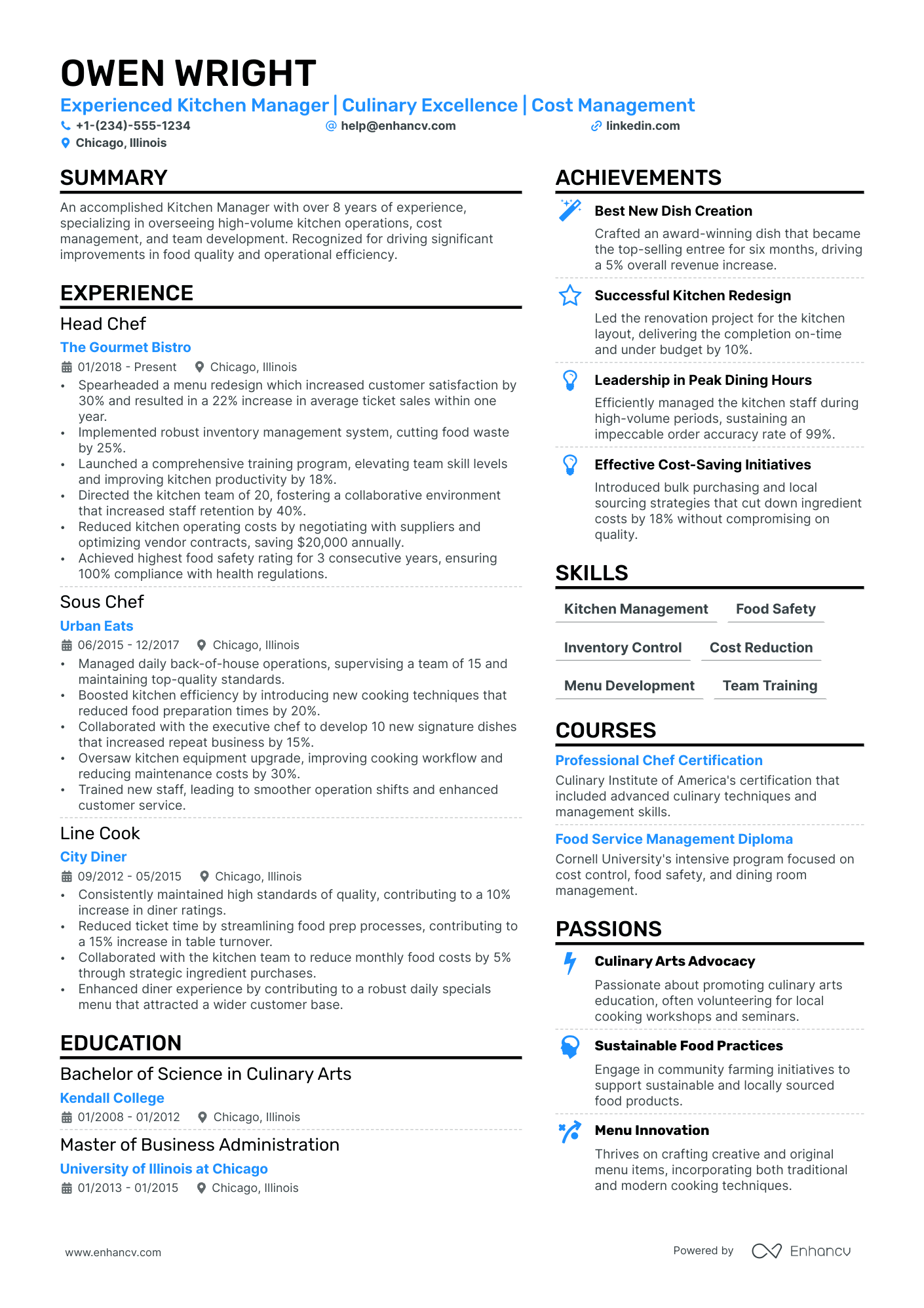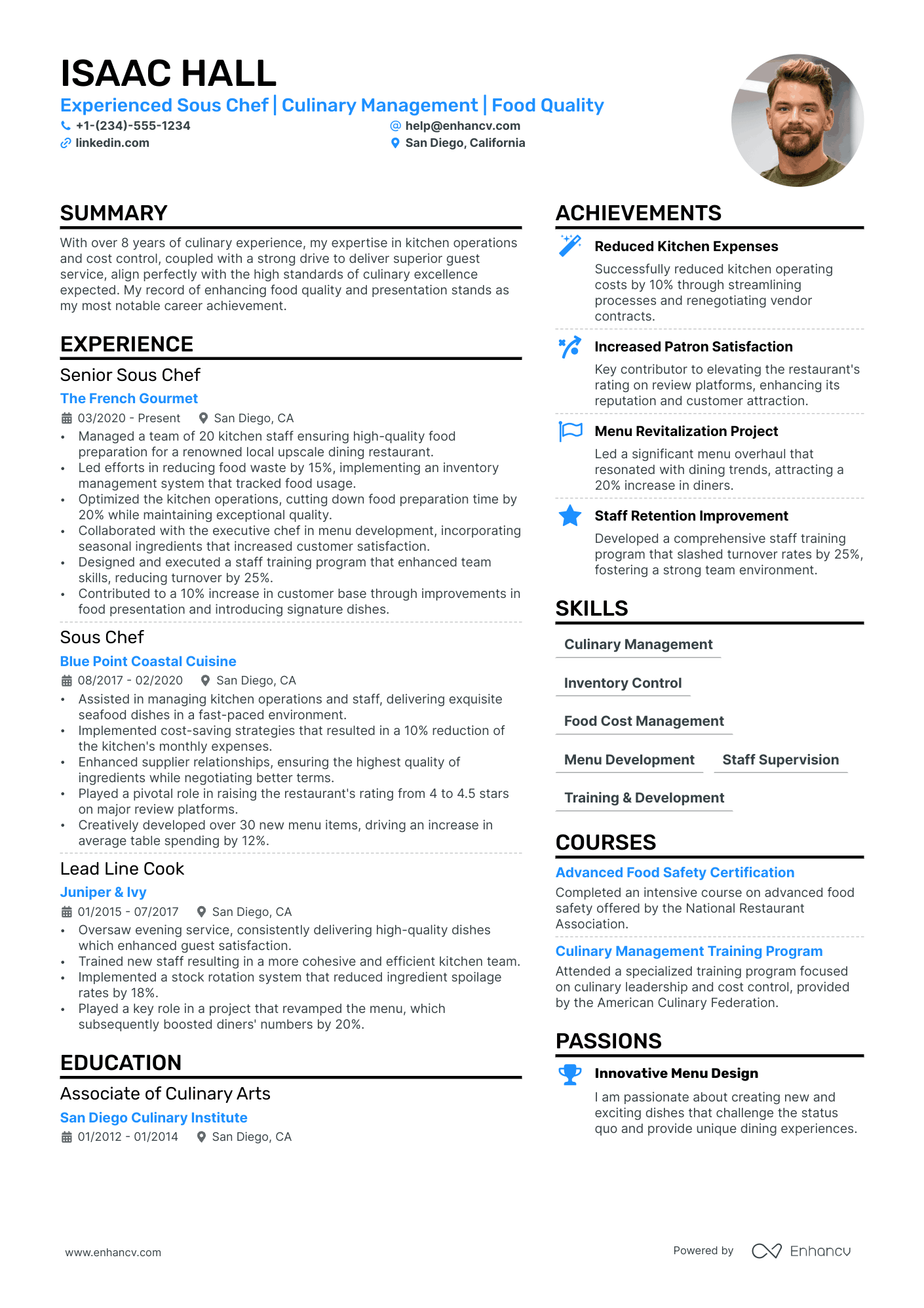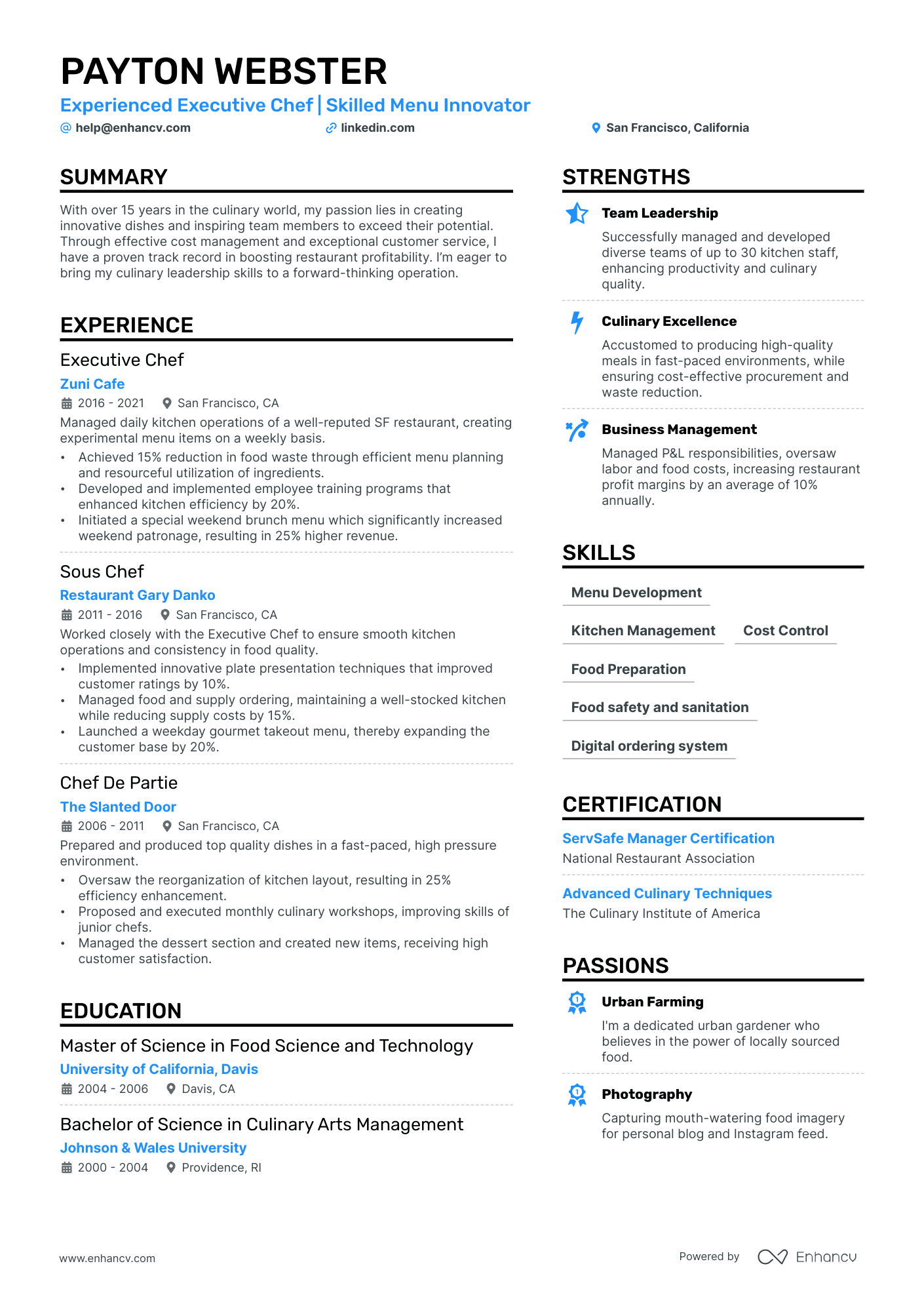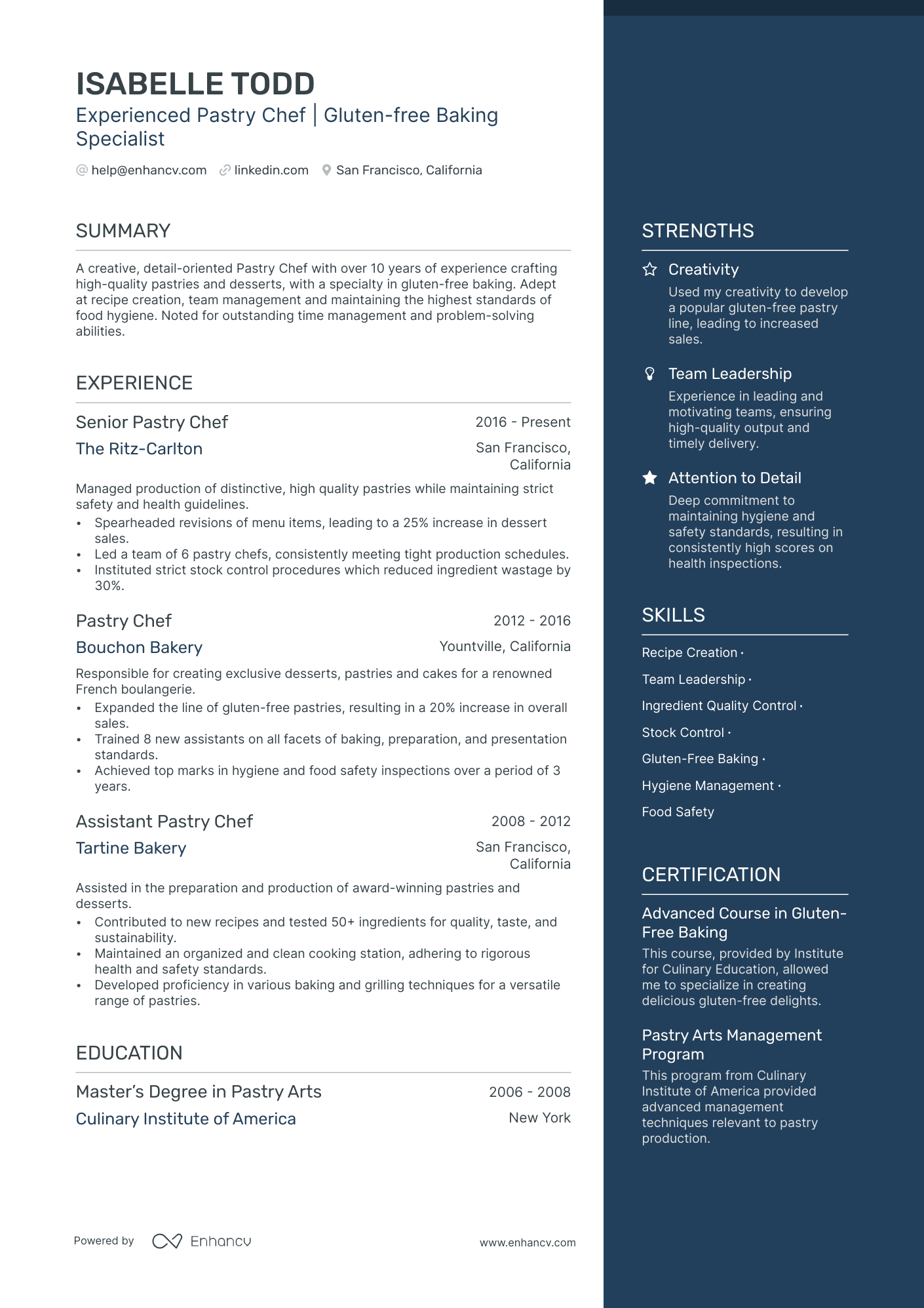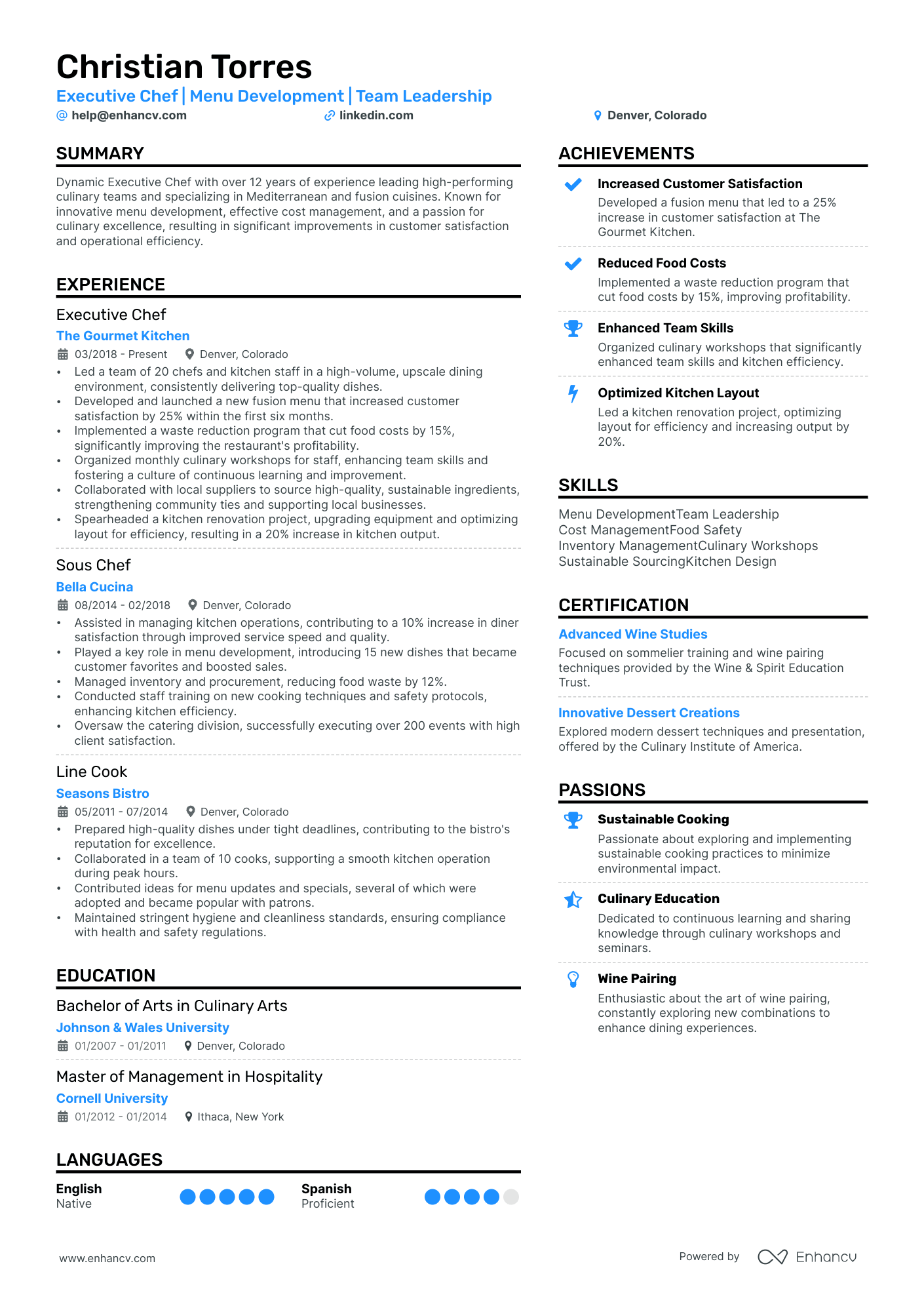Being a chef is one of the most demanding jobs on the market - not only physically but psychologically. The list of challenges facing a chef seems daunting but is well-known in the industry.
Anthony Bourdain said, “To be a good chef, first and foremost, you have to be a good technician. You have to know how to cook. It's like being a musician. You can be a great musician technically and not have much to say. You can also be a technically mediocre musician and still have a lot of soul."
It’s imperative to demonstrate that you’re prepared to meet these demands with pinpoint abilities and talents. You need to prove that you have the technical tools and chef experience to effectively overcome any challenge.
You have to show them that you are the whole package and that you can deliver regardless of the back-of-house situation.
Here’s how we’re going to get you in that kitchen:
- We’ll provide you with a plethora of chef resume examples that you can study and reference
- We’ll advise you on all of the key elements of a resume including how to properly write a chef resume summary and objectives. Also, the best way to showcase your experience or perhaps lack of it.
- You can count on us to show you how to effectively highlight your culinary strengths to stand out from other candidates.
- Full guidance on how to include your chef's hard and soft skills to accurately tackle any challenges in the kitchen.
Want a more specific resume? Here are some other culinary-related resumes to check out:
- Prep cook resume
- Cook resume
- Line cook resume
- Food service manager resume
- Kitchen manager resume
- Food service resume
- Food and beverage manager resume
- Baker resume
- Restaurant operations manager resume
- Hospitality resume
- Restaurant general manager resume
- Restaurant manager resume
Are you wondering what an ideal chef’s resume looks like? Have a look below.
Chef resume example
Here’s what this applicant did well in their resume:
- Highlighting Achievements: They effectively showcased specific achievements, such as developing a fusion menu resulting in an increase of customer satisfaction by 25% as well as implementing a waste reduction program that reduced food costs by 15%. These are quantifiable and directly linked to the key responsibilities of the particular position.
- Leadership and Team Development: They demonstrated strong leadership skills by highlighting their experience leading culinary teams, organizing monthly culinary workshops, and spearheading a kitchen renovation project. This indicates a proactive approach to team management and operational efficiency.
- Specialized Education and Certification: The resume includes several valuable degrees and certificates that emphasize a commitment to continuous learning and specialization. Essential elements for anyone seeking a role in high-end culinary management.
A chef’s resume format that gets results
Just like with a dish coming out of the kitchen, the format, structure, and design of your resume all play a crucial role in making a strong first impression. In essence, they aren’t just about aesthetics; they are integral to effectively communicating your professional story.
As with every position, there are different levels of employees with varying degrees of experience and education. It’s the same in the culinary world whether you’re applying for a head chef position or as a line cook. That means it's essential to follow a particular format according to the job and experience you possess.
If you’ve just recently decided to take your passion for cooking to a professional level, the best sort of resume for you is the functional one. This type uses a skills-based layout that lets you highlight skills and leaves your lack of experience in the background.
However, if you’re an established chef with years of experience, then the reverse-chronological resume would suit you better. It really puts your life as a chef into focus, listing all your previous positions in a reverse-chronological format, thus showing how you’ve grown to become the kitchen ninja you are.
It’s often the case that you belong in the grey area between these two extremes - neither a pro nor a noob. Which brings us to the hybrid resume. Through its innovative and fresh format, it allows you to underline your relevant cooking skills without diminishing your valuable experience.
What’s more, the hybrid format lets you display your achievements so that you stand out from the competition, even if they have a more impressive history than you.
Here are some common concepts that you need to know about when writing your resume:
- Reverse Chronological Format: a reverse chronological format is when you list the most recent experience first on your resume. The reason why this format is the most widely used one is that you can highlight your career trajectory - the evolution of your cooking career.
- Header: Your header is the first thing that jumps off the page of your resume. In your header, you can include contact information on how to reach you, as well as a photo of yourself.
- Length of a resume: Although there’s no cut-and-dry rule for how long a resume should be, it’s best to stick to between 1-2 pages, since most recruiters lose interest after the second page.
- What file format to use: Unless otherwise specified, the PDF file format beats out a simple Word document because PDFs are easy to share and don’t have the same issues with images shifting around.
- Choose the right font: A standard 12p font should be used. The most used font types are Rubik, Lato, Montserrat, Raleway, Exo 2, and Volkhov as well as all the overly used serif and sans-serif fonts.
A quick note on ATS optimization
ATS stands for Applicant Tracking System. This is the digital gatekeeper that some applications have to pass through before a recruiter will even look at it - so your resume must be compatible. It would be useful for you to take a look at how the system works and some myths that surround it.
Although there are some companies out there that use ATS, most systems don't as of 2024 - that’s not to say someday soon these AI features will become commonplace. However, it’s worth noting that larger restaurant chains do use the system so it would be a good idea to make the changes needed to comply with possible ATS encounters - better safe than sorry!
The top sections on a chef resume:
- Professional Summary: It succinctly communicates your culinary experience and specialties, making you stand out.
- Skills and Competencies: This presents your culinary abilities, food knowledge, and any specific cuisines you are proficient in.
- Work Experience: It provides detailed information about your role, achievements, and impact in previous chef positions.
- Education and Certifications: It showcases any formal culinary training or relevant certifications, assuring quality and professionalism.
- References: These can confirm your skills, performance, and work ethic, imparting a strong impression.
What recruiters want to see on your resume:
- Culinary Skills: Recruiters look for specific skills such as food preparation, recipe customization, and knowledge of various cooking techniques which are crucial in a kitchen environment.
- Work Experience: Previous experience as a chef or in a related culinary position is important as it demonstrates reliability and understanding of the role.
- Certifications and Training: Formal culinary education or certifications assert a candidate's credibility and expertise in the field not to mention dedication.
- Kitchen Management Abilities: Skills in inventory control, meal planning, and kitchen equipment maintenance are valued as they directly impact the restaurant's operation efficiency and costs.
- Creativity and Presentation: As chefs often need to create and present new dishes, being creative and having an eye for food presentation are attributes that recruiters prioritize.
Effectively highlighting your cooking experience
The experience section outlines your work history, detailing past positions, employers, and employment dates. It highlights your responsibilities and achievements in each role, showcasing your skills and how you've applied them. This section is vital for employers to assess your suitability and experience for the position you're applying for.
As a chef, it is imperative that you highlight experience more than formal education. Unlike many other professions, chefs often learn more "on the job" than through formal education. Portraying this experience in a professional and compelling way on a resume can be difficult. What you focus on really depends on the particular job and its requirements - so pay close attention and tailor the information!
There’s nothing worse than listing experience that has no relevance to the position you’re applying for! Your summer job at the second-hand clothes shop has zero significance in this resume.
Let’s take a look at a couple of example experience sections that you may see on a chef’s resume. The first demonstrates an ineffectual attempt, while the second shows a much better one.
- •Required to show up on time
- •Managed to keep things clean
- •Participated in recipes
- •Responsible for developing and executing seasonal dessert options alongside a team of three other pastry chefs, ultimately enhancing customer satisfaction
- •Managed inventory and procurement of high-quality ingredients, reducing waste by 15%
- •Specialized in French patisserie techniques, creating award-winning croissants and macarons
- •Conducted pastry workshops and cooking classes, increasing restaurant's community engagement
- •Streamlined bakery operations, improving production efficiency by 20%
In the first example, it’s painfully obvious that the applicant probably doesn’t care too much and is sending out their resume en masse. The description is vague and we can’t discern anything about the company besides that it’s in Idaho. Besides that they misspelled the word ‘diner’ as ‘dinner’ - make sure that you proofread your resume several times before sending it out!
In the second example, the description is spot on accurately describing the workplace and type of cuisine. This is followed by a comprehensive list of duties and responsibilities that utilize action verbs, avoid overused buzzwords and, we would like to assume, keywords taken from the job advertisement and reused here.
The line cook lists too few responsibilities and completely forgets to list any achievements or successes - quantifying nothing. The latter candidate really makes an effort to highlight their achievements as well as properly quantifying a couple of them, e.g. Managed inventory and procurement of high-quality ingredients, reducing waste by 15% - it’s clear they took responsibility and achieved a successful result of reducing waste by 15%.
Be clear, concise, and quantify!
Let’s dive into quantifying a bit more as it can often be a hurdle for many candidates.
How to quantify impact on your resume
The numbers and statistics that you list actually help to show that you know what you’re doing and that you’ve achieved success. As a food industry employee, there are many opportunities to quantify, and the more the better. Employers want results and they want them to be easily conveyed - prove to them that you can do this!
Here are some useful things you can include in your experience section that can easily be quantified:
- Include the number of menu items you created or improved upon at your previous employment to demonstrate innovation and responsibility.
- Indicate how many special diets or food allergies you've accommodated to highlight flexibility and customer care.
- Mention the number of staff you've trained or mentored, showing leadership and cooperative skills.
- Show the percentage by which you reduced food costs without compromising quality, reflecting cost efficiency and resourcefulness.
- Include the number of repeat customers tied to your culinary creations which demonstrates your ability to attract and maintain clientele.
- Mention the increase in customer satisfaction ratings during your tenure to emphasize your impact on service quality.
- Reference the volume of meals served during special events or rush hours to reflect your stamina and ability to work under pressure.
- State the percentage decrease in kitchen waste achieved under your supervision as it signals your commitment towards sustainability and efficient use of resources.
How do I write a chef resume with no experience?
The first piece of advice to anyone in any industry who is just entering is to focus on creating an outstanding education section. Highlight coursework, activities, and projects, and your GPA (if it's 3.5 or higher!). In addition to education, include internship experience, extracurricular activities, volunteering, side projects, hobbies, passions, and, most importantly for a chef, a skills section.
If you have a minute read our detailed article on writing resumes with no experience. Otherwise, here are some steps to follow:
- Write a resume objective: Crafting a resume objective or summary varies with your experience level. Veterans in the field can highlight their extensive experience through real-world successes. However, if you're newer to the industry, focus on outlining your ambitions and what you aim to achieve in the role you're seeking. Emphasize your enthusiasm for specific cuisines or culinary techniques to show your passion.
- Use applicable experience to show competency: Even if you haven't been employed in a restaurant setting, it's likely that you possess relevant experience that could make you a great fit for the job. For instance, your involvement in preparing meals at a shelter or coordinating a potluck event for your nephew's school are opportunities where you can demonstrate your culinary skills.
- Highlight your education section: If you've recently graduated, you can illustrate your suitability for the position by highlighting projects you undertook during your studies. For example, if you designed a lunch menu for your high school cafeteria as part of a class project, mention this experience on your resume and briefly describe the research you conducted for it.
- Consider the functional resume format: This type uses a skills-based layout that lets you highlight skills and leaves your lack of experience in the background. Under the skills section, be sure to list all skills and practical examples from your life and career.
Other aspects that you could include are:
- Internships
Similar to the coursework, a relevant internship can set you apart from the majority of job applicants. The goal here is to emphasize on duties and achievements accomplished during your internship.
- Extracurricular Activities
Many students choose to make room in their schedules for extracurricular activities. Most schools offer a variety of clubs, sports, and organizations that students can participate in.
- Volunteering experience
Hiring managers prefer applicants with volunteer experience. This is because they believe unpaid work builds leadership and communication skills, shaping a strong character.
- Projects
Another way to enrich your resume without work experience is by adding activities and projects that correlate with the position you are applying for.
- Hobbies and interests
What’s the difference? Hobbies are passions in the form of regular activities that you enjoy doing, while interests are something you’re curious about and want to learn more.
Interests lead to hobbies.
- Passions
Passions can be used to enhance the effect of the hobbies and interests section.
Let’s move on to the most critical section for a chef - the skill section.
How to list your hard skills and soft skills on your resume
For a chef's resume, hard and soft skills play distinct roles, each highlighting different aspects of their capabilities and suitability for a role. Here's a breakdown of the differences:
Hard Skills
Hard skills refer to the technical abilities and knowledge necessary for specific tasks related to cooking and kitchen management. These skills are often acquired through formal education, training, and hands-on experience.
Soft Skills
Soft skills, on the other hand, are the personal attributes and interpersonal skills that determine how well someone can work or interact with others. These skills are crucial in a kitchen environment, which often requires teamwork, communication, and stress management.
When crafting a resume, a chef should aim to balance hard and soft skills to present themselves as well-rounded candidates. Hard skills demonstrate technical competence, while soft skills show how they'll fit into the kitchen's culture and work with the team. Including examples of how these skills have been applied in past roles can further strengthen a chef's resume.
Here are some steps to help you showcase your skills in the best way possible
- Identify Relevant Skills
Review Job Descriptions: Start by examining job postings that interest you. Note the skills frequently mentioned as requirements or preferences.
Match Your Skills: Compare your own skills with those listed in the job descriptions. Identify both hard and soft skills that match.
Consider Your Achievements: Think about your professional achievements and how your skills contributed to these successes.
- Categorize Your Skills
Hard Skills vs. Soft Skills: Separate your skills into hard skills (technical abilities) and soft skills (interpersonal and personal qualities).
Specialized Sections: For certain professions, you might also categorize skills into more specific sections (e.g., "Culinary Skills" and "Management Skills" for a chef).
- Prioritize Your Skills
Relevance: Prioritize skills based on their relevance to the job you're applying for. The most relevant skills should be listed first.
Strength: Also consider your level of proficiency and experience with each skill. Highlight your strongest skills that match the job requirements.
- Use Keywords from Job Descriptions
Match the Language: Use the same wording as the job description when listing your skills. This can help your resume pass through Applicant Tracking Systems (ATS) and catch the eye of hiring managers.
- Provide Evidence
Contextualize Skills: Whenever possible, provide context for how you've used your skills. This can be through bullet points under each job in your experience section.
Quantify Achievements: Use numbers and data to quantify your achievements. For example, "Increased kitchen efficiency by 20% through improved inventory management techniques."
- Format for Readability
Clear Section: Create a distinct section for your skills, usually near the top of your resume after your contact information and summary.
Bullet Points: Use bullet points to list your skills, making them easy to read at a glance.
Consistent Formatting: Ensure your resume has consistent formatting throughout. This includes font size, bullet style, and spacing.
- Review and Update Regularly
Tailor for Each Job: Customize the skills section for each job application based on the job description and requirements.
Keep Current: Regularly update your resume as you acquire new skills and experiences.
Here are some more examples of culinary skills:
Best hard skills for your chef resume
- Recipe Development
- Inventory Management
- Culinary Techniques
- Menu Development
- Specialized Cuisine Knowledge
- Budgeting and Cost Control
- Catering
- Baking and Pastry Skills
- Knowledge of Nutrition
- Food Plating and Presentation
- Quality Control
- Food Safety and Hygiene
- Kitchen Equipment Use
- Knowledge of Food Allergies and Dietary Restrictions
- Butchery Skills (Knife Skills)
- Sauteing and Grilling
- Seafood Preparation
- Wine & Other Alcohol Pairing
- Use of Commercial-grade Kitchen Appliances
- Experience with Sous-vide Method
- Mastery of Gastronomy Software
Best soft skills for your chef resume
- Detail Orientation
- Multitasking
- Stress Management
- Leadership
- Decision Making
- Patience
- Time Management
- Adaptability
- Communicative
- Flexibility
- Teamwork
- Problem Solving
- Customer Service
- Creativity
- Motivation
- Cultural Awareness
- Physical Stamina
- Energy
- Precision
- Diplomacy
Including your education and certifications on your chef’s resume
Yes, providing an education section on a chef's resume is important, even though the culinary field often places a strong emphasis on practical skills and experience. The education section can offer valuable insights into a candidate's foundational knowledge, commitment to the profession, and potential for growth. Here's why it matters:
- Demonstrates Formal Training
- Highlights Relevant Coursework
- Shows Commitment to Professional Development
- Provides Context for Career Path
- Fulfills Employer Expectations
Presenting your professional development as a chef
Describing your professional development on a chef's resume is key because it can showcase your commitment to staying up-to-date and enhancing your culinary skills, which, as you know, is absolutely crucial in the ever-evolving food industry.
By illustrating your career progression and the proactive steps you've taken towards personal and professional development, you effectively communicate your value as a dynamic and competent culinary professional, making you more attractive for the position.
How to format your education
- Name of the Institution: Start with the name of the culinary school or university.
- Location: Include the city and state.
- Degree or Diploma: Specify the degree or diploma earned.
- Major or Focus: Mention your major or area of focus, if applicable.
- Graduation Date: Include your graduation date or expected graduation date.
- Relevant Courses or Achievements: Optionally, list relevant courses, projects, or academic achievements.
Here’s an example:
- •Specialized in French Cuisine & pastry arts
- •Completed a capstone project on sustainable sourcing practices
- •Graduated with Honors
In conclusion, while the culinary field values experience and skill highly, the education section of a chef's resume remains a crucial component. It provides a comprehensive view of the chef's background, formal training, and commitment to their craft.
Best certifications for your chef resume
- Certified Executive chef (CEC) by the American Culinary Federation (ACF)
- Certified Sous chef (CSC) by the American Culinary Federation (ACF)
- Certified Master chef (CMC) by the American Culinary Federation (ACF)
- Prochef Certification by the Culinary Institute of America (CIA)
- ServSafe Food Safety Certification by the National Restaurant Association
How to write your chef resume summary or objective
A resume summary is a concise introduction at the top of your resume that outlines your key qualifications, skills, and achievements relevant to the job you're applying for. It aims to quickly convince employers of your suitability, showcasing your unique value and professional background in just a few sentences.
A resume objective is a brief statement at the beginning of your resume that goes over your career goals and how you aim to contribute to the prospective employer. It highlights your aspirations, relevant skills, and why you're interested in the position, aiming to show how your objectives align with the company's goals.
So, a resume objective is forward-looking, focusing on your future aspirations and what you hope to achieve, while a resume summary is backward-looking, emphasizing what you have already accomplished and how that makes you a great fit for the job.
How to make a good resume summary or objective statement
A good resume summary for a chef succinctly highlights extensive culinary experience, specialized skills in cuisine or technique, proven achievements in kitchen management or menu innovation, and a passion for culinary excellence. An effective objective statement focuses on career goals, relevant skills, and how they align with the restaurant's mission.
Here are some examples to illustrate:
Why It's Bad: This summary lacks specificity, quantifiable achievements, and clear skills or specialties. It fails to convey the candidate's unique value or how they can contribute to a potential employer, making it less compelling and informative.
Why It's Good: This summary is effective because it clearly outlines the chef's experience, areas of specialization, key achievements with quantifiable results, and commitment to important industry trends, making the candidate stand out.
Key takeaways
As you can see producing an effective resume that gets you the chef’s job you’ve been dreaming about is going to take some effort and commitment… but it’s worth it! Put the time in and your resume will get you that result!
So, here’s what we takeaway:
- To be successful in your job hunt, you need to dedicate yourself to creating the best possible resume.
- It’s imperative that you follow a format and include accurate and impactful information.
- Proofread your resume several times! Simple errors could really put a potential employer off.
- If something is not relevant to your cooking career, it shouldn’t be on your resume.
- The main focus of a chef’s resume is on the skills sections. Match your skills to the ones in the job description.
- The summary or objective is your first line of offense so make it great!
Chef resume examples
Explore additional chef resume samples and guides and see what works for your level of experience or role.
By Experience
Entry Level Chef
By Role
